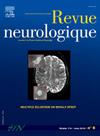由DNA甲基化谱确定的多形性黄质星形细胞瘤的MRI特征。
IF 2.3
4区 医学
Q2 CLINICAL NEUROLOGY
引用次数: 0
摘要
简介:多形性黄色星形细胞瘤(PXA)是一种原发性脑肿瘤,由于其形态和分子与其他肿瘤有重叠,诊断难度很大。虽然DNA甲基化谱(MP)有助于病理分类,但它本身可能不具有决定性。磁共振成像(MRI),常规进行病变评估,提供有价值的信息。因此,结合组织分子特征、MP和MRI是有益的,特别是在诊断不确定的情况下。在这项研究中,我们使用WHO 2021标准回顾性分析了甲基化证实的pxa (mcpxa)与pxa样组织学肿瘤的MRI特征。方法:我们纳入了29例具有pxa提示组织学,完成MP和术前MRI的成年肿瘤患者。肿瘤分为三组:mcPXA、组织学PXA伴甲基化证实的胶质母细胞瘤(mcGBM)和其他mp确诊诊断(mcMimic)。记录临床和分子数据。结果:所有肿瘤均位于幕上,呈非均匀强化。mcGBM组肿瘤周围水肿和细胞增生明显多于mcPXA组(P=0.002和P=0.023)。在肿瘤位置、囊性成分或出血内容方面没有发现显著差异。BRAFV600E突变出现在89%的mcPXA、8%的mcGBM和29%的mcMimic病例中(结论:在组织学不确定的病例中,缺乏肿瘤周围水肿和高细胞性支持PXA的表观遗传谱。我们的具体评分可以帮助在具有挑战性的情况下,尽管进一步验证在更大的队列是必要的。本文章由计算机程序翻译,如有差异,请以英文原文为准。
MRI features of pleomorphic xanthoastrocytoma defined by DNA methylation profile
Introduction
Pleomorphic xanthoastrocytomas (PXA) are primary brain tumors challenging to diagnose due to their morphological and molecular overlap with other tumors. While DNA methylation profiling (MP) aids pathological classification, it alone may be inconclusive. Magnetic resonance imaging (MRI), routinely performed for lesion assessment, provides valuable information. Combining histo-molecular features, MP, and MRI is thus beneficial, particularly in cases of diagnostic uncertainty. In this study, we retrospectively analyzed MRI features of methylation-confirmed PXAs (mcPXAs) versus tumors with PXA-like histology using WHO 2021 criteria.
Methods
We included 29 adult patients with tumors displaying PXA-suggestive histology, completed MP, and preoperative MRI. Tumors were classified into three groups: mcPXA, histological PXA with methylation-confirmed glioblastoma (mcGBM), and other MP-confirmed diagnoses (mcMimic). Clinical and molecular data were recorded.
Results
All tumors were supratentorial with heterogeneous enhancement. The mcGBM group showed significantly more peritumoral edema and hypercellularity than mcPXA (P = 0.002 and P = 0.023). No significant differences were found in tumor location, cystic components, or hemorrhagic content. The BRAFV600E mutation appeared in 89% of mcPXA, 8% of mcGBM, and 29% of mcMimic cases (P < 0.05). Our composite MRI and molecular score for PXA diagnosis achieved an area under the curve of 0.95, with 95% specificity and 77% sensitivity.
Conclusion
In cases of histological uncertainty, lack of peritumoral edema and hypercellularity supports a PXA epigenetic profile. Our specific score could aid in challenging cases, though further validation in larger cohorts is warranted.
求助全文
通过发布文献求助,成功后即可免费获取论文全文。
去求助
来源期刊

Revue neurologique
医学-临床神经学
CiteScore
4.80
自引率
0.00%
发文量
598
审稿时长
55 days
期刊介绍:
The first issue of the Revue Neurologique, featuring an original article by Jean-Martin Charcot, was published on February 28th, 1893. Six years later, the French Society of Neurology (SFN) adopted this journal as its official publication in the year of its foundation, 1899.
The Revue Neurologique was published throughout the 20th century without interruption and is indexed in all international databases (including Current Contents, Pubmed, Scopus). Ten annual issues provide original peer-reviewed clinical and research articles, and review articles giving up-to-date insights in all areas of neurology. The Revue Neurologique also publishes guidelines and recommendations.
The Revue Neurologique publishes original articles, brief reports, general reviews, editorials, and letters to the editor as well as correspondence concerning articles previously published in the journal in the correspondence column.
 求助内容:
求助内容: 应助结果提醒方式:
应助结果提醒方式:


